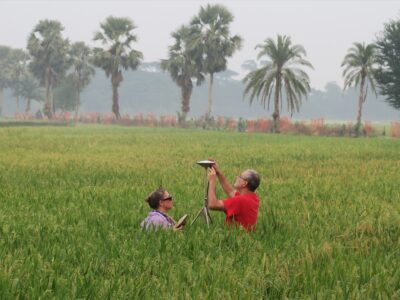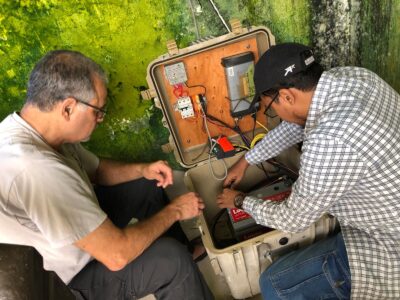
After a great field season last winter, we had an extraordinary opportunity this fall, a research cruise on the Bangladeshi rivers collecting geophysical data. We are using the same technique that Lamont uses on its ship, the R/V Marcus Langseth, but a mini version. The basic idea is to use sound waves from bursts of compressed air to bounce off the layers of sediment below the surface and to record it on a string of microphones towed behind the ship called a streamer. The difference is scale. While the Langseth can tow four 6-km long streamers, we have one 50-m streamer. Our source is similarly reduced. The system we are using, built by Bremen University in Germany, will only see a few hundred meters below the surface, but with great detail. The cruise is taking place on the M/V Kokilmoni, an 85-ft long boat built for tourist cruises of the Sundarban mangrove forest, home of the Bengal tiger.
While the Bremen group and a few of the Americans will stay on the entire 25-day cruise, the rest of us have the opportunity to join and leave the ship during the cruise, something not possible in the middle of the ocean. Due to other commitments and, in part, not wanting to be there for the inevitable problems at the beginning of the cruise like this, joined the ship today, over a week after the scheduled start (less than as week after the actual start). Nano Seeber, Rafael Almeida and myself left Lamont on Monday, Sept 12 and after a long set of flights arrived in Dhaka at 4:00 AM Wednesday morning. We dropped some equipment off at Dhaka University, picked up Humayun Akhter and a student and headed off to find the ship. This was not as easy as we thought. They were entering the area of the Sylhet Basin that floods every year and there were not too many places where car and boat. Talking while driving north, we came up with three places where we could meet. They past the first one hours before we could get the, but worked out a plan for number two, saving probably 5 more hours of driving to get to the third. We drove out to the meeting place on ever-smaller roads finally ending at a port on this vast inland lake. Using cell phone towers, the tall chimneys of brick factories that are now islands and a hospital ship, we finally located each other and they sent their small boat to pick up us. It brought Dhiman and Pritam as well, returning to Dhaka University with Babu, our driver.

Welcomed on board, we got underway following the markings of where the river channel is across the broad expanse of water. Patches of grass, the occasional tree, islands of homes and lines of telephone poles dot the area that will become fertile farmland again in a few months. I’ve known of the flooding worked on calculations about it, and heard stories, but this was the first time I saw it for myself. I’ve always been here in the cool, dry winter-early spring. It is truly amazing and filled with an amphibious population traveling by bus and rickshaw in winter and boat in summer.




